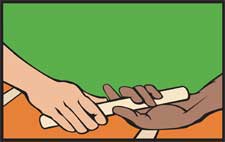Magazine
Not Making History

The baton is preparing to pass to a new generation of Indian Americans born in the USA.
A barely recognized, but seismic shift is taking shape beneath the surface of the Indian American community in the United States. The baton is preparing to pass to a new generation born in the USA.
Demographers have long recognized that Indian Americans are predominantly immigrants. The 2000 Census found that 73 percent of the community was foreign born. What that statistic masked, however, was that although 89 percent of Indian Americans 18 years and over are immigrants, fully 86 percent of those under 18 are native born. The impact the new generation born in the past 20 years in the United States will have in community affairs and the broader society is still another decade away. But the nearly 200,000 native born adult Indian Americans in college and the work force are already reshaping the contours of the community’s identity. The image of immigrant Indians is well established in the American psyche. They have the highest educational attainment and are the most affluent of any ethnic group in the country, including Whites. They constitute nearly a third of the technology workers in Silicon Valley and are behind nearly 1 in 4 immigrant start-ups. They own nearly half of all motels and convenience stores in the country and are the single largest foreign medical group, comprising nearly 5 percent of all U.S. physicians. Each of these accomplishments has been heralded first by the community, then absorbed by popular culture from The Simpsons to Jay Leno to Garry Trudeau, before assuming a resentful stereotype that has thrown many a presidential candidate for a loop, from Hillary Clinton (“Gandhi ran a gas station down in St. Louis”) to Joe Biden (“You cannot go to a 7-Eleven or a Dunkin’ Donuts unless you have a slight Indian accent”). You know your time is up when it begins to hurt. Elbowing onto the stage and into the limelight is a new generation of Indian Americans born in the USA confident of their claim and their place at the American table. People like astronaut Sunita Williams, only the second Indian American woman in space; U.S. Congressman Bobby Jindal, tipped to become the first Indian American governor of a state; Hollywood director and producer M. Night Shyamalan, who headlined a Newsweek magazine cover as “The Next Steven Spielberg”; 8-time Grammy winner Norah Jones; CNN medical star Dr Sanjay Gupta; Supermodel Saira Mohan; St. Louis Rams linebacker Brandon O’Neil Chillar, etc., etc. No matter that some of them have only tenuous connections with their Indian American identity. A few, like Sunita Williams, Norah Jones and Brandon Chillar are only half Indian, the products of multiracial relationships. Some others for personal, professional or ideological considerations may even steer clear of their Indian roots. They are, nonetheless, the emerging public face of the new Indian American identity. And it’s time we begin to take stock of the changes they have already wrought and will increasingly bring. The publicly visible second generation Indian Americans are still in their 20s and 30s and have yet to peak. Over the next few years, they will be joined by tens of thousands more U.S. born Indian Americans and will inexorably reshape the form and character of the community, whose public and private identity for the past two decades has been defined by the still predominant immigrant generation. Their time has come none too soon. Two years ago, a New York Indian newspaper headlined on its front page a story about an Indian American attorney who “made history” by becoming the first Indian to appear three times before the U.S. Supreme Court. Thankfully, Generation Next will save us the ignominy of such lame historical accomplishments. |

